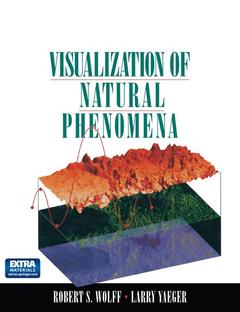Visualization of Natural Phenomena, Softcover reprint of the original 1st ed. 1993
Langue : Anglais
Auteurs : Wolff Robert S., Yaeger Larry

by David C Nagel In the last five years visualization has gone from the lab to become a desktop technology for many scientists. Images and 3-D renderings of data sets and mathematical models have evolved from the high-priced hardware and customized software of graphics professionals to low-cost, off-the-shelf commercial software running on personal computers. fu such, scientific visualization has taken its place beside mathematical modeling as an everyday means of interacting with one's data. This has significantly changed both the amount and the quality of information that scientists are able to extract from raw data, and has effectively established a new paradigm for scientific computing. In addi tion, new, low-cost hardware and software technologies such as CD-ROMs, digital video, and Apple's QuickTime time-based media of image and and compression technologies have enabled large amounts animation data to be easily accessible to the average researcher or teacher through the personal computer. However, little has been done in the way of providing a context within which the researcher or teacher could learn which approaches might be best suited for a given problem. Furthermore, most scientists are unfamiliar with the terminology and concepts in modern computer graphics, which simply steepens the learning curve for them to apply the new technologies to their work. fu a result, researchers and teachers are not yet taking full advantage of the new paradigm.
Book Table of Contents.- 1 Images and Image Processing.- Imaging: Another Dividend from Space Exploration.- Beyond Visible Images.- Summary.- 2 Imaging Numbers.- Historical Background.- Contour Plots and Related Techniques: Pre-Images.- More Imaging Examples.- Desktop Animation.- Data Compression.- Putting It on Tape.- Summary.- 3 Through Canyons and Planets.- Methods of Altimetry.- 3-D Animation: Flying Over Terrain.- Examples.- Summary.- 4 Visualization of Multivariate Systems.- Basic Visualization Techniques.- Advanced Visualization Techniques.- Special Problems.- Molecular Visualization.- Geophysics.- Planetary Astrophysics.- Summary.- 5 Volume Visualization.- Historical Background.- Volume Visualization as a Research Tool.- Basic Techniques in Volume Visualization.- Data Integrity Issues.- Algorithms.- Summary.- 6 Modeling Animationy and Rendering.- Surface Modeling.- Scene Composition and Animation.- Rendering.- Special Topics.- Applying Surface Visualization Techniques.- Summary.- 7 Visualization in Film and Television.- A Brief History of Computer Graphics in Film.- How Tough Is This Job?.- A Look at the Production Process.- Design and Modeling.- Scene Composition and Animation.- Rendering.- Color Calibration.- Final Filming.- Integration with Live Action.- The Planet Jupiter in 2010.- Summary.
Ouvrage de 374 p.
21x27.9 cm
Thème de Visualization of Natural Phenomena :
© 2024 LAVOISIER S.A.S.
